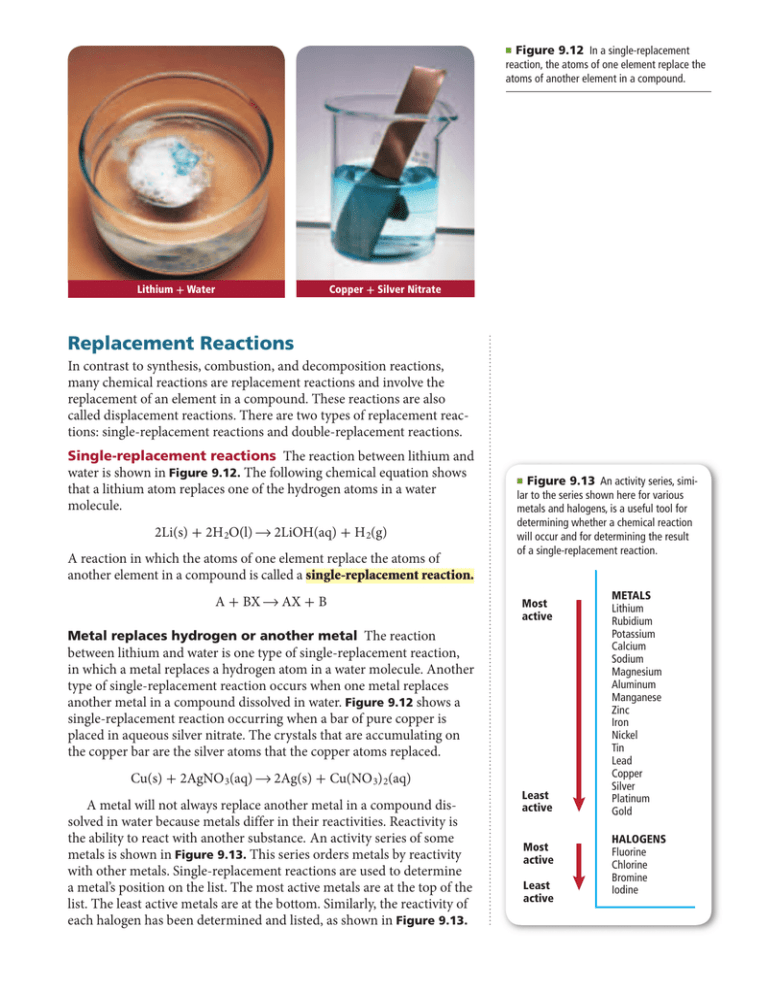Activity Series
advertisement

Figure 9.12 In a single-replacement reaction, the atoms of one element replace the atoms of another element in a compound. ■ Lithium + Water Copper + Silver Nitrate Replacement Reactions In contrast to synthesis, combustion, and decomposition reactions, many chemical reactions are replacement reactions and involve the replacement of an element in a compound. These reactions are also called displacement reactions. There are two types of replacement reactions: single-replacement reactions and double-replacement reactions. Single-replacement reactions The reaction between lithium and water is shown in Figure 9.12. The following chemical equation shows that a lithium atom replaces one of the hydrogen atoms in a water molecule. 2Li(s) + 2H 2O(l) → 2LiOH(aq) + H 2(g) A reaction in which the atoms of one element replace the atoms of another element in a compound is called a single-replacement reaction. A + BX → AX + B Figure 9.13 An activity series, similar to the series shown here for various metals and halogens, is a useful tool for determining whether a chemical reaction will occur and for determining the result of a single-replacement reaction. ■ Most active Metal replaces hydrogen or another metal The reaction between lithium and water is one type of single-replacement reaction, in which a metal replaces a hydrogen atom in a water molecule. Another type of single-replacement reaction occurs when one metal replaces another metal in a compound dissolved in water. Figure 9.12 shows a single-replacement reaction occurring when a bar of pure copper is placed in aqueous silver nitrate. The crystals that are accumulating on the copper bar are the silver atoms that the copper atoms replaced. Cu(s) + 2AgNO 3(aq) → 2Ag(s) + Cu(NO 3) 2(aq) A metal will not always replace another metal in a compound dissolved in water because metals differ in their reactivities. Reactivity is the ability to react with another substance. An activity series of some metals is shown in Figure 9.13. This series orders metals by reactivity with other metals. Single-replacement reactions are used to determine a metal’s position on the list. The most active metals are at the top of the list. The least active metals are at the bottom. Similarly, the reactivity of each halogen has been determined and listed, as shown in Figure 9.13. Least active Most active Least active METALS Lithium Rubidium Potassium Calcium Sodium Magnesium Aluminum Manganese Zinc Iron Nickel Tin Lead Copper Silver Platinum Gold HALOGENS Fluorine Chlorine Bromine Iodine You can use the activity series to predict whether or not certain reactions will occur. A specific metal can replace any metal listed below it that is in a compound. It cannot replace any metal listed above it. For example, copper atoms replace silver atoms in a solution of silver nitrate. However, if you place a silver wire in aqueous copper(II) nitrate, the silver atoms will not replace the copper. Silver is listed below copper in the activity series, so no reaction occurs. The letters NR (no reaction) are commonly used to indicate that a reaction will not occur. EXAMPLE Problem 9.2 Single-Replacement Reactions Predict the products that will result when these reactants combine, and write a balanced chemical equation for each reaction. a. Fe(s) + CuSO 4(aq) → b. Br 2(l) + MgCl 2(aq) → c. Mg(s) + AlCl 3(aq) → 1 Analyze the Problem You are given three sets of reactants. Using Figure 9.13, you must first determine if each reaction occurs. Then, if a reaction is predicted, you can determine the product(s) of the reaction. With this information you can write a skeleton equation for the reaction. Finally, you can use the steps for balancing chemical equations to write the complete balanced chemical equation. 2 Solve for the Unknown a. Iron is listed above copper in the activity series. Therefore, the first reaction will occur because iron is more reactive than copper. In this case, iron will replace copper. The skeleton equation for this reaction is Real-World Chemistry Single-Replacement Reactions Fe(s) + CuSO 4(aq) → FeSO 4(aq) + Cu(s) This equation is balanced. b. In the second reaction, chlorine is more reactive than bromine because bromine is listed below chlorine in the activity series. Therefore, the reaction will not occur. The skeleton equation for this situation is Br(l) + MgCl 2(aq) → NR No balancing is required. c. Magnesium is listed above aluminum in the activity series. Therefore, the third reaction will occur because magnesium is more reactive than aluminum. In this case, magnesium will replace aluminum. The skeleton equation for this reaction is Mg(s) + AlCl 3(aq) → Al(s) + MgCl 2(aq) This equation is not balanced. The balanced equation is 3Mg(s) + 2AlCl 3(aq) → 2Al(s) + 3MgCl 2(aq) 3 Evaluate the Answer The activity series shown in Figure 9.13 supports the reaction predictions. The chemical equations are balanced because the number of atoms of each substance is equal on both sides of the equation. PRACTICE Problems Predict whether the following single-replacement reactions will occur. If a reaction occurs, write a balanced equation for the reaction. 21. 22. 23. 24. K(s) + ZnCl 2(aq) → Cl 2(g) + HF(aq) → Fe(s) + Na 3PO 4(aq) → Challenge Al(s) + Pb(NO 3) 2(aq) → Zinc plating Tools made of steel are often covered with a layer of zinc to prevent corrosion. Zinc is more reactive than the lead in steel. During zinc plating, the zinc replaces some of the surface lead, coating the steel.



